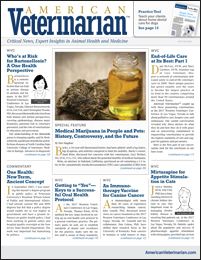A Novel Quantitative PCR Assay Improves Detection of Babesia
The new test uses mitochrondrial DNA and shows higher sensitivity and better detection over testing with ribosomal DNA.
Researchers have developed a novel quantitative polymerase chain reaction (qPCR) assay using mitochondrial DNA. Compared with an established qPCR assay that uses ribosomal DNA, this new assay has a broader range of Babesia spp detection and greater sensitivity, according to a study recently published in Parasites & Vectors.
Babesiosis is a tick-borne protozoal disease with global distribution. Several Babesia species, including Babesia gibsoni and Babesia canis, can infect dogs. Canine babesiosis can cause splenomegaly, anemia, and fever and may be fatal.
Current methods for diagnosing babesiosis include microscopic analysis of peripheral blood smears, immunofluorescence antibody testing, and PCR.
To amplify Babesia DNA using PCR, highly conserved genes— particularly 18S ribosomal RNA—are often the preferred gene targets. These conserved genes are useful for differentiating between genera but not species. Fortunately, sequences of ribosomal DNA contain hypervariable regions that allow for species differentiation.
Previously, researchers at North Carolina State University developed an 18S ribosomal DNA qPCR assay to detect and differentiate between a broad range of Babesia species. Because 18S ribosomal RNA sequences can vary between distantly related Babesia species, though, developing an assay to detect all Babesia species while excluding the DNA amplification of other eukaryotic pathogens has proven challenging. Species-specific PCR assays could address this challenge, but they are costly and can have low amplification efficiency.
Prior studies have investigated the use of mitochondrial DNA in qPCR. Although these studies’ results suggest greater sensitivity with mitochondrial DNA than 18S, 18S continues to be a method of choice for PCR.
For the current study, the authors used 13 Babesia mitochondrial DNA sequences to design three primers for a novel qPCR assay, named LSU qPCR. Plasmid clones, constructed using LSU qPCR amplicons from two Babesia species, were used as standards for evaluating PCR efficiency and analytical sensitivity.
The authors evaluated sensitivity and specificity using whole blood samples that were archived (retrospective testing) or more recently collected (prospective testing). Archived samples came from cats, dogs, and other mammals; samples were naturally infected with Babesia or Cytauxzoon felis (n = 31), naturally infected with a different vector-borne pathogen (n = 13), or uninfected (n = 4). In total, 12 Babesia species were represented in the archived samples.
Prospective testing was performed with canine blood samples (n = 394) initially collected for vector-borne diseases.
qPCR Efficiency
PCR efficiency is a measure of how efficiently a PCR product duplicates during each cycle of the amplification phase. The LSU qPCR efficiency was 92% to 100%.
Analytical Sensitivity and Specificity
To assess analytical sensitivity of LSU qPCR, the authors determined the limit of detection. For this study’s purposes, limit of detection was the lowest concentration of DNA primer (number of DNA copies/μL) needed to achieve a 95% detection rate of Babesia-positive samples. Two- or 3-primer combina- tions were added in one of two concentrations (3 or 5 copies/ μL) to the reaction wells.
Detection rates were 95% to 100% with 5 copies/μL and 60% to 90% with 3 copies/μL. The limit of detection was thus determined to be 5 copies/μL for the LSU qPCR. C. felis was the only non-Babesia vector-borne pathogen amplified in the LSU qPCR.
Clinical Sensitivity and Specificity
The authors compared the clinical sensitivity and specificity of the LSU qPCR and established 18S qPCR. The following results were observed:
- Retrospective testing (Babesia- or Cytauxzoon-positive archived samples) 100% (31/31) were LSU qPCR positive 84% (26/31) were 18S qPCR positive
- Prospective testing (canine samples) 4.8% (19/394) tested Babesia-positive on LSU qPCR 2.8% (11/394) tested Babesia-positive on 18S qPCR
Interestingly, 8 prospective samples that were 18S qPCR negative were LSU qPCR positive. Such discordance could be attributed to several factors, such as increased DNA copy numbers and whether the patient was treated or untreated at the time of sample collection. However, the authors noted, the reason for the discordance remained unclear.
The authors calculated the positive and negative percent agreements to determine the relative sensitivity and specificity between the 2 qPCR assays. Relative to 18S qPCR, LSU qPCR had 100% sensitivity. Relative to LSU qPCR, 18S qPCR had 58% sensitivity. Importantly, this finding suggests greater sensitivity with LSU qPCR than 18S qPCR.
Limitations and Conclusions
One study limitation was the inability to determine the LSU qPCR assay’s true sensitivity and specificity. In addition, LSU qPCR was compared with only one other qPCR. Despite these limitations, LSU qPCR demonstrated improved sensitivity over that of 18S qPCR, both retrospectively and prospectively.
Taken together, this study’s findings demonstrate greater sensitivity and improved Babesia spp detection when performing qPCR with a highly conserved region from mitochondrial DNA rather than 18S ribosomal DNA.
Dr. Pendergrass received her DVM from the Virginia-Maryland College of Veterinary Medicine and completed a postdoctoral fellowship at Emory University’s Yerkes National Primate Research Center. Dr. Pendergrass is the founder and owner of JPen Communications, LLC, a medical communications company.
